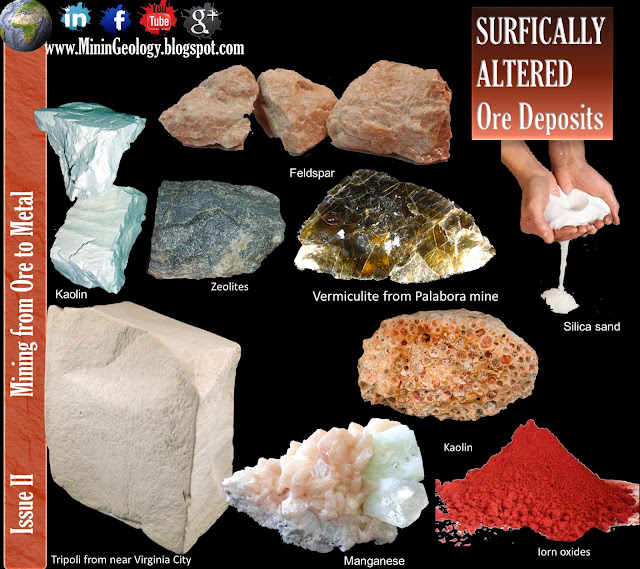Feldspar-rich deposits subject to weathering break down to form feldspathic sand deposits such as those exploited in the western United States and in Spain. Further weathering forms a mixture of feldspar, silica, and kaolin such as that mined in Bavaria. Still further decomposition through weathering or hydrothermal activity eliminates much of the mica and silica and yields premier-quality deposits of kaolin such as those mined in Cornwall in the United Kingdom, Georgia and the Carolinas in the southeastern United States, and the Amazon Basin of Brazil. These areas produce virtually all the coating-grade material. Other suppliers of quality kaolin include France, Germany, the Czech Republic, Malaysia, and Australia.
Vermiculite
Vermiculite belongs to a group of minerals called the mica minerals. The mica group of minerals includes: biotite, muscovite, lepidolite, and phlogopite.
It is a supergene alteration product formed by the combined effects of weathering and circulating groundwater or derived by alteration of biotite and phlogopite. Large-scale commercial production is confined to South Carolina and Virginia in the United States and the Palabora Complex in South Africa, which contributes 70% of world supplies. Minor quantities come from China, Russia, Brazil, Zimbabwe, Japan, Australia, and Egypt.
Bauxite
It is a supergene alteration product formed by the combined effects of weathering and circulating groundwater or derived by alteration of biotite and phlogopite. Large-scale commercial production is confined to South Carolina and Virginia in the United States and the Palabora Complex in South Africa, which contributes 70% of world supplies. Minor quantities come from China, Russia, Brazil, Zimbabwe, Japan, Australia, and Egypt.
Uses:
Vermiculite is used in a number of different applications. The majority of vermiculite is used annually for agriculture and insulation purposes. In agriculture it is used in horticulture and mixed with soil to create a more porous, absorbent soil. As an insulator, it is used both as a heat and sound insulating material. Vermiculite is added to concrete mixtures to create a lightweight concrete mix.Bauxite
Because residual bauxite deposits result from the tropical weathering of a variety of source rocks, their distribution is based on climatology rather than lithology. Formation is encouraged by long periods of tectonic stability permitting deep and thorough weathering.
Most bauxite deposits are post-Cretaceous in age and many occur in modern tropical regions. Bauxite provinces have been defined as follows:
• Guiana Shield of South America (Venezuela, Guyana, Surinam, Guiana, and parts of Brazil and Colombia)
• Caribbean Shield Province (Costa Rica, Jamaica, Dominican Republic, Haiti, and Puerto Rico)
• Guinea Shield Province (Guinea-Bissau to Togo)
• Cameroon Province (Cameroon, Zaire)
• Australian Province
• European Province (France, Greece, Hungary, and Yugoslavia)
• Others (United States, China, former U.S.S.R., India, and Malaysia).
A dozen countries contribute 95% of world production, with more than 75% coming from Australia, Guinea, Jamaica, China, and Brazil. Nonmetallurgical grades used for refractories, abrasives, chemicals, and aluminum cement are confined to specific deposits in China, Australia, Guinea, Brazil, Guyana, and Suriname.
Manganese
Manganese
Manganese is found in most geological environments; the commercially more important being sedimentary and residual. Large sedimentary marine deposits of manganese are exploited in Ukraine, the former U.S.S.R., the Kalahari Basin of South Africa, Groote Eylandt in Australia, and Mexico. Residual deposits are important in Ghana and Gabon in West Africa and in Amapá, Brazil. More than 90% of world production comes from eight countries—China, South Africa, Ukraine, Brazil, Gabon, Australia, India, and Kazakhstan.
Nonmetallurgical grades constitute a relatively small percentage of output from these major suppliers, plus smaller tonnage producers such as Ghana, Morocco, and Greece.
Iron OxidesIron oxides are generally associated with volcanic activity and sulfide deposits combined with subsequent leaching and diagenic alteration. India is the world’s largest supplier with more than 70% of production, followed by the United States with an additional 10%. European production is centered in Spain, United Kingdom, France, Italy, and Austria (the last being the main source of natural micaceous oxide). Cyprus is noted for its variety of iron oxides, including ocher and umber.
Tripoli
Iron Oxides
Tripoli
Tripoli is a microcrystalline, friable, high-silica (98% to 99%) material formed from the weathering of siliceous limestone. The only large-scale commercial producers are in the United States, specifically the southwestern Missouri–northeastern Oklahoma region, southern Illinois, and the Ouachita Mountain region of Arkansas. Deposits in the latter region are associated with novaculite.
Zeolites
Natural zeolites are formed through the reaction of pore water with volcanic glass, clay, feldspar, and a variety of other rocks and minerals. Although zeolites have been recognized in virtually all parts of the world, large-scale commercial production is restricted to the western United States, Cuba, Japan, and several eastern European countries, including Bulgaria.








0 komentar:
Post a Comment